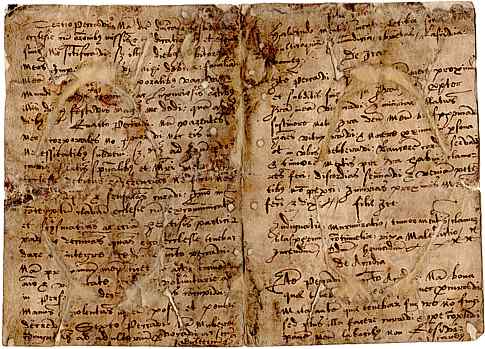
Before we take a look at the script of this document it is necessary to tell you something about its story. Every so often people will send me images of medieval manuscript items in their possession, asking me if I can transcribe or translate them, or tell them anything about them. Almost inevitably, please note, the answer is no. I have a backlog of material to prepare for the site, and it is slow work, and the function of the site is to teach you to do it yourself. However, on this occasion there was something truly strange and fascinating about the document and the story behind it.
David and Carol are the owners of an ancient and historic house in Knaresborough, Yorkshire. They are still trying to work out exactly how ancient, and that is another story. There are tales, but as yet no precise corroboration, that the house may have had some associations with the Trinitarian Friary at Knaresborough, of which no other trace remains above ground. Possibly it belonged after the dissolution of the friary to the former minister of the friary, one Thomas Kent, or perhaps it didn't. Investigations are ongoing.
During the course of some restorations, they discovered this document scrunched up and poked into a hole in a roof beam, which was then sealed over. Naturally, having spent a few centuries in this situation, it is in less than perfect condition, with some parts badly rubbed, but enough can be made out to get some idea of what it is. My first thought was that it was likely to be some old title deed, stashed against the random events of tempestuous times. But it isn't.
The sheet of parchment is written on both sides, and was clearly folded down the middle to make a little booklet. It contains a confession of sins in Latin. Now why would anybody write down a confession and then seal it up within the structure of a building? One possibility was that the room may have been a priest's hole for a recusant Catholic family. Apparently that was, in fact, another rumour about the house, but it seemed that the room in question was more likely a ham smoking room, as it was tucked in behind a chimney. The two are not necessarily mutually exclusive. However, the document was not found in that room, but in the roof beam of an aisle of the old aisled hall that sits inside centuries of later modifications.
The cursive script of the document is a bit informal and untidy, but is nevertheless an educated hand, and in Latin. The style of writing is entirely consistent with the early 16th century. The sins being confessed to are distinctly clerical in nature; not fearing, adoring or serving God, loss of faith, promulgating false doctrines, blasphemy, laxity in performing the Sunday masses and orations and the divine office, and various other things. He seems particularly concerned about anger and its consequences. It seems to alternate between a formal exposition of conventional sins and a more personal rendition. He writes that his mind is on approaching death, at which point the text seems to lose its organising principle and starts to ramble. He asserts that one of the consequences of spiritual sloth is wandering of the wits, and he is perhaps suffering from it.
So a reasonable supposition is that it is the confession of a priest, literate and educated in Latin, dating from the period around the Reformation. It is a uniquely personal document, very different from the formal legal proclamations that tell you what happened but not what anybody thought about it. Could it be the confession of Thomas Kent, the man who handed over his friary to the king and had to change his entire religious practice? Does this document reflect the agony of a man questioning the choices he made in the practice of his faith in times of great stress and difficulty? Or perhaps it represents the thoughts of some other aged cleric dying in distress in those trying times. It is still mysterious as to why he had to write out his confession and hide it, rather than confess it to a priest, which was still allowed for some time after the Reformation. Perhaps he thought his sins would not be understood by the current crop of young whippersnapper priests. It isn't actually clear from the confession just which beliefs he regarded as the sacred word and which were the false doctrines. Thomas Kent complied with the king, despite some dissent from within his friary.
I actually found this document quite creepy, but perhaps I was exercising an excess of imagination. If anybody out there has some extraordinary knowledge of these matters, we are open for communication on the subject. Just email me.
Meanwhile, we do have an authentic example of the handwriting of Thomas Kent, on the surrender document for the friary from December 1538, which he and the other friars have each signed in their own hands. You can decide for yourself whether it looks sufficiently like the script of the document when you look at it in detail.

If you are looking at this page without frames, there is more information about medieval writing to be found by going to the home page (framed) or the site map (no frames).